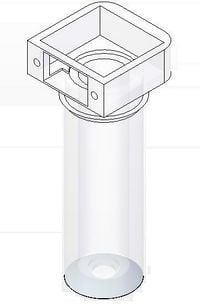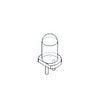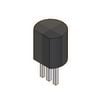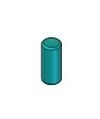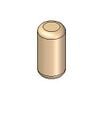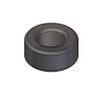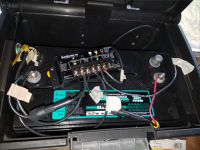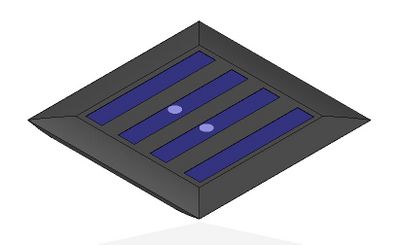| Line 233: | Line 233: | ||
{| class="wikitable" style="margin: 1em auto 1em auto" text-align: center | {| class="wikitable" style="margin: 1em auto 1em auto" text-align: center | ||
|+ '''Table 4: Parts List and Description''' | |+ '''Table 4: Parts List and Description''' | ||
! Part Name || Information || CAD Representation | ! Part Name || Information || CAD Representation | ||
|- | |- align=center | ||
| 1 x Housing || To be produced || [[Image:Housing.jpg| | | 1 x Housing || To be produced || [[Image:Housing.jpg|200px|Image: 200 pixels]] | ||
|- | |- align=center | ||
| 1 x LED ||5mm, White, 3V ||[[Image:LED.jpg|100px|Image: 200 pixels]] | | 1 x LED ||5mm, White, 3V ||[[Image:LED.jpg|100px|Image: 200 pixels]] | ||
|- | |- align=center | ||
| 1 x Transistor || BC549, 30V, 100mA, NPN || [[Image:Transistor.jpg|100px|Image: 200 pixels]] | | 1 x Transistor || BC549, 30V, 100mA, NPN || [[Image:Transistor.jpg|100px|Image: 200 pixels]] | ||
|- | |- align=center | ||
| 1 x Diode || IN5711, 70V, 15mA, DO-35 || [[Image:Diode.jpg|100px|Image: 200 pixels]] | | 1 x Diode || IN5711, 70V, 15mA, DO-35 || [[Image:Diode.jpg|100px|Image: 200 pixels]] | ||
|- | |- align=center | ||
| 1 x Resistor || 271-1321, 1/4W, 1kohm || [[Image:Resistor.jpg|100px|Image: 200 pixels]] | | 1 x Resistor || 271-1321, 1/4W, 1kohm || [[Image:Resistor.jpg|100px|Image: 200 pixels]] | ||
|- | |- align=center | ||
| 1 x Transformer || Ferrous Ring || [[Image:Transformer.jpg|100px|Image: 200 pixels]] | | 1 x Transformer || Ferrous Ring || [[Image:Transformer.jpg|100px|Image: 200 pixels]] | ||
|- | |- align=center | ||
| 1 x AAA Rechargeable Battery || NIMH AAA, 1.2V, 1000mAH || | | 1 x AAA Rechargeable Battery || NIMH AAA, 1.2V, 1000mAH || [[Image:Battery.jpg|200px|Image: 200 pixels]] | ||
|- | |- align=center | ||
| 1 x Switch || DPDT Slide Switch || | | 1 x Switch || DPDT Slide Switch || [[Image:Switch.jpg|100px|Image: 200 pixels]] | ||
|- | |- align=center | ||
| 2 x 3mm Screw || NIMH AAA, 1.2V, 1000mAH || | | 2 x 3mm Screw || NIMH AAA, 1.2V, 1000mAH || [[Image:Screw.jpg|50px|Image: 200 pixels]] | ||
|- | |- align=center | ||
| 1 x Solar Panel || 2V, 70mA, 0.14W || | | 1 x Solar Panel || 2V, 70mA, 0.14W ||[[Image:Solar Panel.jpg|400px|Image: 200 pixels]] | ||
|- | |- | ||
|} | |} | ||
=== Prototype - Grassroots Methodology === | === Prototype - Grassroots Methodology === | ||
Revision as of 16:28, 30 March 2010
Project Description
- The main goal of this Mech425 project is to design a simple, cost effective indoor light source that can be used in areas of the world that do not have access to electricity or functional lighting at night. If this design proves successful and viable, the technical specifications as well as methodology and costs will be available to anyone who has access to the internet or to programs such as the One Laptop Per Child (OLPC) Program.
- The proposed design utilizes a recycled bottle and cap (with a cap diameter equal to or greater than that of a 2L pop bottle) as a portable, durable platform for a high efficiency LED lighting system that is charged using a small solar panel. The bottle cap will house the lighting equipment, will act as the bulb ballast and the pop bottle will act as the diffuser and stand.
Background
LED Technology
LED is an acronym for a lighting system known as a light-emitting diode. LED's are semiconductors that emit light when a junction is exposed to a forward biased electrical charge (electro luminescence). This application will use white LED's, which can be used as a much more efficient replacement for incandescent light bulbs. The main advantages of LED use are the efficiency and lifespan compared to standard incandescent bulbs. First of all, LED's produce many more lumens/watt of light than incandescent bulbs, resulting in a reduced power requirement as well as increased running time when powered by batteries. They also have extremely long lifetimes (anywhere from 100 000 to 1 000 000 hours) compared to incandescent bulbs (1000-2000 hours) [1][2] [3].
These qualities have made LED lighting ideal for grass roots, low power applications such as this project, and have been used in similar endeavors. Some examples include:
Barefoot Power, which develops AC and solar lighting products for the developing world and is involved with projects such as Lighting Africa and
The Lumina Project [4]
SOLLIGHT TM, which is a solar LED system designed for wide mouthed water bottles [5]
Cosmos Ignite Innovations, which provides lighting solutions for developing nations. [6]
Lighting Issues Around the World
Approximately two billion people, almost 30% of the world population has no access to electricity, relying on fuel-based lighting, such as kerosene wick lamps and candles. This is a very dangerous alternative that is unsafe, expensive, and provides very inefficient lighting. Being limited by the amount of sunlight during the day makes it very difficult to perform tasks efficiently at night. The main problem is that these tasks include homework or studies by adults and children, and without proper lighting, reading books or chalkboards is impossible. This presents a barrier to education and economic development not to mention literacy improvement. Efficient, self sufficient lighting can therefore impact the well being of people who cannot function efficiently after the sun has set. [7]
A major push to switch to LED lighting is the widespread use of dangerous, expensive fuels such as kerosene. Kerosene is very expensive for people living in poverty. In places such as rural India, purchasing enough kerosene to light a small household can represent more than 4% of a household budget. The light that these kerosene lamps produce is also very inefficient; LED’s can produce more than 200 times the useful light. For example, an entire village can be lit using less energy than a single 100W normal bulb [8].
Making the switch to solar powered LED lighting systems not only presents a more cost effective, efficient alternative, but also a much safer one. According to the World Health Organization, indoor air pollution from kerosene and other burned fuels used for indoor lighting and cooking is the cause of more than 1.5 million deaths annually [8]. There is also additional risk of fire when using kerosene, giving yet another reason to switch to LED lighting.
LED Light Source Design Requirements
The design must fulfill the following functional requirements in order to be an appropriate solution to the lighting problem:
- System Cost: The cost of the system must be minimized as much as possible in order for people in developing countries who survive on as little as $1 per day to afford it without marginalizing food and shelter requirements. If the cost is too high, people will not be able to cover the overhead, and will not be able to benefit from safe, efficient lighting.
- Simplicity: The design must be as simple as possible in order to minimize overhead costs and complexity. This simplicity will lead to increased durability and lifespan.
- Maintenance: The design must be easy to maintain, with little to know technical knowledge required. It must therefor be a contained unit that requires no additional maintenance other than initial installation.
- Self Sufficient: The light must be able to charge and run itself without any additional charging or battery replacement. The solar cell must fully charge the battery when exposed to peak sunlight during the day, and the battery must retain the charge without replacement over a long period of time.
- Environmental Impact: The production and operation of the light must be optimized with regards to environmental impact. This means that the component choice must maximize the use of recycled materials and the end of life disposal must produce minimal impact.
- Ease of Use: The installation and use of the light must be as simple as possible in order to minimize the chance of confusion or degradation due to misuse.
The functional requirements have been weighted according to relative importance with respect to applications in developing nations. The results are shown in Table 1.
| Function Requirement | Importance Weighting |
|---|---|
| System Cost | 50 |
| Simplicity | 10 |
| Maintenance | 10 |
| Self Sufficient | 10 |
| Environmental Impact | 10 |
| Ease of Use | 10 |
| Total Weight | 100 |
Each of the functional requirements and their relative importance will be considered in the design of the LED lighting system. The first step is to design the circuit that will power the LED.
Circuit Design
The first step in this light source design is the circuitry. A solar charged battery light circuit is relatively simple, because the energy input can be modeled as an external power source, and the battery can be charged constantly without backward current flow using a diode. The only problem with compact LED lighting systems is the limitation of voltage from small battery packages. AAA's and AA's (which will be used in this application) are limited to maximum 1.5V, which is half of the optimum voltage for a white LED. This problem leads to two distinct circuit design solutions; one that is simple and runs the LED at 3V but requires 2 batteries and one that is complex that runs the LED at the full voltage through the use of a voltage booster. The circuit diagram for the simple solution can be seen in Figure 1.
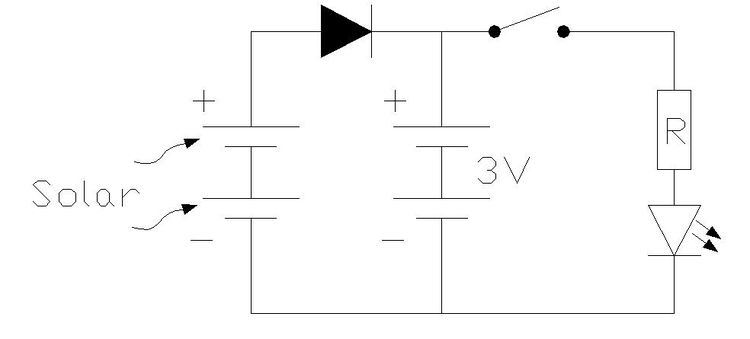
This simple solution would result in suitable performance but would require 2 batteries (which is relatively expensive and environmentally costly)and depending on the LED choice, would not need a resistor. This layout can possibly extend the life of the light because it is running at a slightly lower voltage.
The components required the 'simple' circuit with 2 batteries totaling 3V will be:
Battery:
Solar Panel:
Resistor:
Not required due to the limited voltage being supplied.
The diagram for the single 1.5V battery with a more 'complex' wiring solution can be seen in Figure 2.
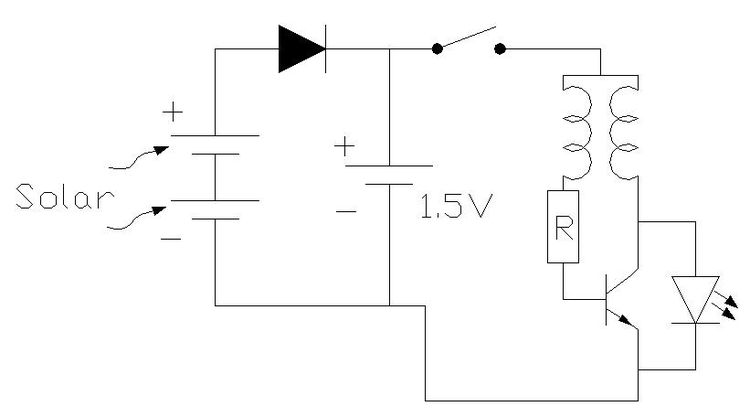
This 'complex' solution would result in optimum lighting quality from the LED, but would significantly increase the cost of parts and manufacturing as well as limit the life of the device (voltage boosters are limited to a few hundred hours of runtime, depending on the voltage increase required[9]). The inductance based voltage booster can be made from a ring of ferrous material wrapped in 2 separate copper wires, and provides a simple, relatively cheap solution to the lack of voltage produced by the battery [10]. The main advantage is the reduction in reliance on 2 batteries, hence reducing the cost and environmental impact. [11]
The components required the 'complex' circuit with for a single 1.5V source boosted to approximately 4.5V will be:
Battery:
Solar Panel:
Resistor:
Circuit Economic Analysis
In order to determine which of the two wiring options is more suitable to this low cost, simple application, a simple economic evaluation must be performed. Whichever option provides a more cost effective parts and labor outcome will be used in the final design. Tables 2 and 3 show the summary of parts and costs in order to determine the total individual circuit costs. Please note that the labor costs have been approximated based on the possibility of manufacturing in China where the labor rate is lower [12].
| Component | Price | Information | Vendor |
|---|---|---|---|
| AAA Battery [13] | $0.53 | BTY NIMH 1000 mAH AAA | Hotock Group |
| AAA Battery [13] | $0.53 | BTY NIMH 1000 mAH AAA | Hotock Group |
| Diode [14] | $0.28 | Schottkey 60V 15 mA Diode | STMicroelectronics |
| Switch [15] | $0.42 | N/A | N/A |
| LED [16] | $0.68 | 5mm White LED | PCToys |
| Solar Panel (4V) [17] | $5.48 | 4V 60 mA 0.24W | Keawin |
| Labor [12] | $1.20 | ||
| TOTAL | $9.12 |
| Component | Price | Information | Vendor |
|---|---|---|---|
| AAA Battery [13] | $0.53 | BTY NIMH 1000 mAH AAA | Hotock Group |
| Diode [14] | $0.28 | Schottkey 60V 15 mA Diode | STMicroelectronics |
| Switch [15] | $0.42 | N/A | N/A |
| Transformer | $0.45 | Ferrous ring with coil | N/A |
| Resistor [18] | $0.20 | 271-1321 10K resistor | Radioshack |
| Transistor [19] | $0.11 | BC549 30V 100mA limit | Fairchild Semiconductors |
| LED [16] | $0.68 | 5mm White LED | PCToys |
| Solar Panel (2V) [20] | $3.90 | 2V 70 mA 0.14W | Keawin |
| Labor [12] | $2.10 | ||
| TOTAL | $8.67 |
The excel file can be seen here: File:Wiring Cost Comparison.xls
The more complex, voltage boosting circuit is the least expensive to produce because of the lower power requirement for the solar cell as well as the reduction in number of batteries required. The only limiting factor may now be the lifespan of the voltage boosting transformer, which can be maximized by using high quality components as well as standardized construction procedures. The overall cost of $8.67 CAD is slightly higher than originally predicted for the wiring component of the design, but if the product efficiency and environmental impact can be optimized, then the additional price is worthwhile.
Bottle Cap LED Fixture Design
There are two main methodologies that have been explored in order to develop a suitable appropriate technology designation for this design. The first of which relies on mass production (or at least semi-mass production) to justify the housing design as well as the parts purchases. The methodology relies on recycling all parts, which would be relatively difficult where there is little technology available, and designing based on parts available. The first methodology has been applied to develop a single part and assembly methodology that can be mass produced using injection molding and labor in China. The second methodology has been applied through the development of a prototype that utilizes the most recycled components as possible.
CAD Designed - Mass Production Methodology
Parts List and Description
Prototype - Grassroots Methodology
Circuit Construction
Cap Assembly Construction
An online walk through for the construction of the voltage booster portion of the circuit can be seen HERE
Economic Considerations
Conclusions
References
- ↑ Appropedia, "LED Lighting", http://www.appropedia.org/LED, Accessed March 23, 2010
- ↑ Marktech Optoelectronics, White LED's, http://www.marktechopto.com/Engineering-Services/white-leds.cfm, Accessed March 24, 2010
- ↑ Theledlight.com, "Technical Information", http://www.theledlight.com/LED101.html, Accessed March 23, 2010
- ↑ Barefoot Power, "Barefoot Power", http://www.barefootpower.com/, Accessed March 20, 2010
- ↑ Simply Brilliant, LLC, "Sollight",http://www.sollight.com/products/lc200.cfm, accessed March 20, 2010
- ↑ Cosmos Ignite Innovations, "Mighty Light", http://www.cosmosignite.com/product-brief.htm, Accessed March 20, 2010
- ↑ A. Seigel, "Energy Cool: Lighting up the developing world, http://www.huffingtonpost.com/a-siegel/energy-cool-lighting-up-t_b_201954.html, Accessed March 23, 2010
- ↑ 8.0 8.1 Sebitosi A.B., Pillay P., New Technologies for Rural Lighting in Developing Countries: White LED’s, Cape Town University c2007, Accessed March 23, 2010
- ↑ Linverter, "Linverter- Run four superbright white LED from one or two 1.5v batteries", http://www.linverter.com/, Accessed March 24, 2010
- ↑ Z. Kaparnik, Make a Joule Thief, http://www.emanator.demon.co.uk/bigclive/joule.htm, Accessed March 24, 2010
- ↑ EDN, "1.5V battery powers white LED driver, http://www.edn.com/article/CA454645.html, Accessed March 24, 2010
- ↑ 12.0 12.1 12.2 China.org.cn, "Average salary increase of urban workers rises to six year high, http://www.china.org.cn/government/central_government/2008-04/02/content_14111192.htm, Accessed March 25, 2010
- ↑ 13.0 13.1 13.2 Hotock Group, "4x NIMH AAA 1.2V", http://cgi.ebay.ca/4-PCS-Rechargeable-AAA-1000-mAh-1-2V-NI-MH-NIMH-Battery_W0QQitemZ260571034826QQcmdZViewItemQQptZLH_DefaultDomain_0?hash=item3cab3e74ca#ht_3890wt_1009, Accessed March 25, 2010
- ↑ 14.0 14.1 Digi-key Corp, DIODE SCHOTTKY, http://ca.digikey.com/1/1/369732-diode-schottky-70v-15ma-d0-35-1n5711.html, Accessed March 25, 2010
- ↑ 15.0 15.1 ebay, 6X Push Switch Green Circuit Bent ON OFF DS-212 Button, Accessed March 25, 2010
- ↑ 16.0 16.1 PCToys.com, "5mm White LED (4 Pack)", http://www.pctoys.com/840556011286.html, Accessed March 25, 2010
- ↑ ebay, 4V 60mA 0.24W solar panel PV solar power 2.4v battery, Accessed March 25, 2010
- ↑ Radioshack, 1K ohm 1/4 Watt Carbon Film Resistor,http://www.radioshack.com/product/index.jsp?productId=2062343#, Accessed March 25, 2010
- ↑ Digi-key Corp, "TRANS NPN LN 30V 100MA BC549", http://parts.digikey.com/1/parts/1003194-trans-npn-ln-30v-100ma-92-bc549.html, Accessed March 25,2010
- ↑ ebay, 2V 70mA 0.14W solar panel PV solar power PCB panel, Accessed March 25, 2010












